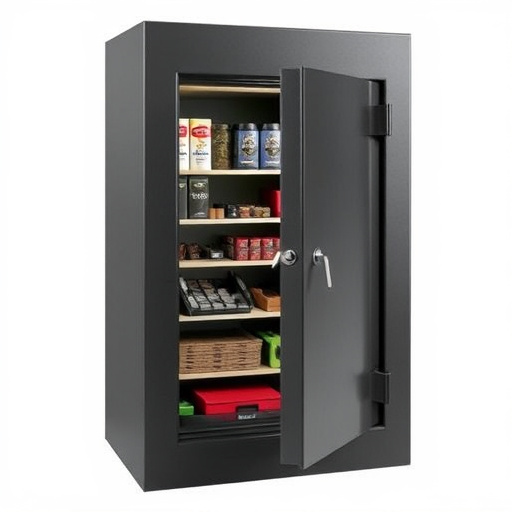Concealment Containers That Look Ordinary provide a creative and discreet way to store valuables in plain sight. These cleverly designed products mimic everyday items like books or food jars, offering a subtle means to hide sensitive materials while integrating seamlessly into homes or offices. By blending realism with robust security features, these containers appeal to those prioritizing both functionality and discretion in their storage methods.
“Uncover the innovative world of Concealment Containers That Look Ordinary, where everyday items transform into secure storage solutions. This article delves into the art of hiding valuables discreetly, exploring diverse consumer goods tailored for safety. From subtle bookcases to innocent-looking travel adaptors, we uncover how ordinary objects can provide advanced protection. Learn about the benefits, challenges, and best practices surrounding this unique approach to securing your possessions, offering peace of mind in an ever-watchful world.”
- Understanding the Concept of Concealment Containers
- Types of Everyday Items That Can Be Used for Secure Storage
- Benefits and Challenges of Disguised Storage Solutions
- Best Practices and Safety Measures for Discreetly Hiding Valuables
Understanding the Concept of Concealment Containers
In the realm of secure storage, concealment containers have emerged as a clever and subtle solution for those seeking to hide valuable items or sensitive materials in plain sight. These ingeniously designed products are crafted to resemble everyday consumer goods, making them an appealing option for individuals looking to keep their possessions safe while maintaining a normal appearance. From books with secret compartments to faux food jars containing hidden safes, these containers offer a unique approach to discretion.
The beauty of Concealment Containers That Look Ordinary lies in their ability to blend seamlessly into any home or office environment. By disguising themselves as common household items, they provide an innovative layer of security, ensuring that valuable assets remain out of sight and reach of unauthorized individuals. This clever use of space and camouflage makes them a popular choice for those seeking both functionality and discretion in their storage solutions.
Types of Everyday Items That Can Be Used for Secure Storage
In the realm of secure storage, creativity often plays a crucial role in keeping valuables hidden and safe. One innovative approach is to utilize everyday items that double as concealment containers. These Concealment Containers That Look Ordinary offer a subtle solution for those seeking discreet storage options. For instance, faux food jars or cans can be filled with documents or small trinkets while appearing as part of a mundane pantry. Similarly, books with hollowed-out pages or faux rock formations can serve as hiding spots for cash or delicate items.
Even common household products like shampoo bottles, makeup cases, or even toy cars can be transformed into secure storage spaces. These Concealment Containers That Look Ordinary are not just practical but also blend seamlessly into their surroundings, making them an attractive option for those looking to hide valuable items without drawing suspicion.
Benefits and Challenges of Disguised Storage Solutions
The concept of secure storage disguised as consumer goods offers a unique and creative approach to enhancing home security. One of the primary benefits is its discretion; concealed within everyday items, these storage solutions provide an undetectable means of safeguarding valuables. Whether it’s a book that secretly holds cash or a fake rock containing precious metals, Concealment Containers That Look Ordinary offer peace of mind by turning regular household objects into safe havens. This method is particularly appealing for those seeking to protect sensitive items from theft or damage without drawing unnecessary attention.
However, challenges exist in this innovative storage strategy. Crafting or acquiring these disguised containers requires skill and attention to detail to ensure they blend seamlessly with their supposed purpose. Moreover, while discretion offers protection, it may also lead to challenges during retrieval if the original placement is forgotten. Despite these obstacles, the allure of hidden storage lies in its ability to provide an extra layer of security while maintaining the appearance of regular household items, making it an intriguing option for savvy homeowners.
Best Practices and Safety Measures for Discreetly Hiding Valuables
When securing valuable items within consumer goods, adopting best practices ensures your secrets remain hidden and safe. Opt for Concealment Containers That Look Ordinary to maintain realism; avoid obvious locking mechanisms or unusual shapes that might draw attention. Instead, choose everyday items like books, food cans, or plant pots that can accommodate hidden compartments. These containers should be sturdy yet lightweight to prevent suspicion during transport or storage.
Implementing safety measures involves a multi-layered approach. First, ensure the hiding place is secure within the ordinary container; use durable materials and creative craftsmanship to seal the compartment tightly. Next, blend it seamlessly with its surroundings. Place the concealed item in a way that it aligns with the expected contents of the container—a book tucked within a bookshelf or canned goods stacked among others. Lastly, maintain discretion during handling; avoid leaving traces or patterns that could betray the hidden value, such as excessive weight or unusual odours.
In today’s world, where discretion is key for many individuals, secure storage disguised as consumer goods offers a unique and innovative solution. By utilizing everyday items transformed into concealed containers, people can safeguard their valuable possessions while maintaining an air of normalcy. This approach, often referred to as Concealment Containers That Look Ordinary, presents numerous advantages, from enhancing home security to providing peace of mind. However, it’s not without challenges; careful selection and implementation are essential to ensure the safety and effectiveness of these hidden storage spaces. By following best practices and adopting appropriate safety measures, individuals can leverage this method to protect their assets discreetly and efficiently.
